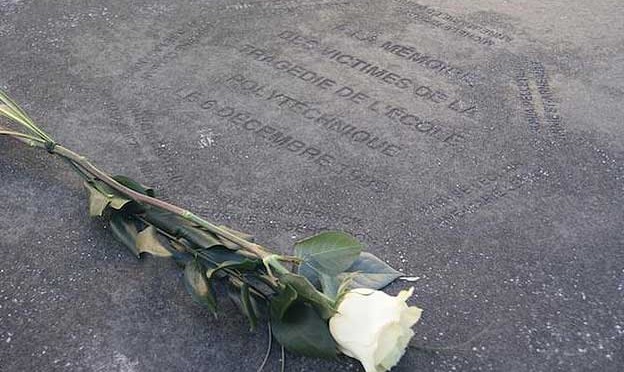By Alia Hogben
The Quran is clear that the burying of live infant girls is a sin for which the murderers will be held responsible, then why does anyone think the killing of women and girls will not be viewed in the same light?
“When the sun is shrouded in darkness and when the stars lose their light…when the girl-child that was buried alive is asked for what crime she was killed…”
Recently in Canada, another acronym – HBV, honour based violence – has surfaced, and many of us will try our damndest to make it irrelevant! To identify these killings by the justification given by men murderers is degrading to those who died, and continues the racism and stigmatizing of these women and girls.
Labelling these murders as honour killings separates these women from the sisterhood of all women and is encouraging further racism by seeing these deaths as somehow alien and distinct from other violence against women murders.
Defining violence against women
The U.N. definition of Violence against Women is “any act of gender–based violence that results in, or is likely to result in, physical, sexual or psychological harm or suffering to women, including threats.” The W.H.O 2002 report on Intimate partner violence, states that the characteristics include physical aggression, psychological abuse, sexual coercion, controlling behaviour, isolating from friends and family and restricting access to information and assistance.
Many of us think that all killings are within this definition of violence against women. Neither of these definitions excludes what is now being labeled as “honour based violence.” However, to differentiate this vile practice some “experts” such as policy makers, service providers, courts and police are adding other elements to allow for a distinct classification of these murders.
“Honour based violence” is being used with great fervour because the federal government has provided a lot of funding to fight against what is seen to be a growing phenomenon introduced by us immigrants, esp. from non-European parts of the world.
Violence against immigrant and Aboriginal women
Don’t we know that violence against women and girls has been almost eradicated in the West including Canada, and woe be to those of us whose religion or culture “allows” for the killing of women and girls within our families?
Along with immigrant women, another group of Canadian women is in the news now –aboriginal women and girls.
Not a surprise that a recent RCMP report on violence and native women cites a lot of statistics to show the inordinate number of women who have been murdered – from 1980 to 2012, 1,017 have been murdered, with 164 who have gone missing. Understandably native groups are calling for a public inquiry and a national action plan.
We can forget that from 1990 to 2002, 476 women have been murdered in Canada, by their husbands, and their stories of jealousies, anger, control, terror and finally killings are not dissimilar to HBV murders.
Recent cases
I have reviewed some recent murders of women by their husbands, and I find little difference between their lives and those of women who are now being labeled as victims of HBV. The non-HBV murders demonstrate the patriarchal values, jealousies, control and misogynist vengeance against females. Dr. Guy Turcotte wreaked havoc by murdering his own children to get at his wife; Howard Richmond killed his wife because she left him; and Rienna Nagel was killed in a “domestic violence incident” according to the police.
Another 2013 case in Montreal of Franklin Bencosme Lora who stabbed his wife to death, in front of their children, was charged with second degree murder. No labelling as an honour killing though he stated he killed her because he would not allow anyone else to have her…
On the other hand, the Ottawa police and media reporting of a recent attempted murder case, of Labib Khawas, was clearly identified as “honour based violence” and they added that there is a rise in such cases.
So doesn’t it make one wonder why the police are now labelling this case as HBV? Is it because the family is Arab, and maybe Muslim? What is different about this man and this family from the Turcottes, Nagels, or Lora?
Who and which group has taken on the task of identifying certain killings as honour killings in Canada? On what grounds did the Ottawa police state that there is an increase of honour killings with the rise in immigrant populations? Who retrospectively identified some murders as HBV and came up with 15, or 20 or 30 murdered women as honour killings? Why is this seen as helpful to us immigrant women?
“Honour crimes” in certain cultures
The argument is that “honour crimes” are located within certain cultures, certainly not within Western cultures. As author Rupa Reddy states,
“The focus on immigrant cultures as determined by violence against women supposes that the culture of the dominant society is inherently less patriarchal and violent and fails to sufficiently interrogate patriarchal practices that exist in Western cultures.”
Gender violence is assumed to be the work of a “deviant individual” while immigrant women suffer from “death by culture.” Certainly, culture should be recognized as part of the problem but the intense focus on cultural rationales leads to stereotyping, stigmatizing and seeing these communities as backward or as “other.”
Reddy adds that promoting views of “honour” as primarily cultural does not address the issues of patriarchy and other values, which is shared in all cases of violence against women.
Femicide
One helpful perspective is described by the U.K. Southall Black Sisters. Their approach is one of using a “mature multiculturalism” lens which understands acts of violence against women “as abuses and violations of women’s fundamental human rights, irrespective of the cultural or religious contexts in which they occur.”
As Diana Russell, and other activists, recommend these should be named as femicide. South African feminists define femicide as the “intentional killing of females by men and by other women in the interest of men.”
The term femicide was first used in Britain in 1820, and I think that women activists of all stripes and races should seriously consider uniting and using this term rather than HBV which is offensive and segregates some of us from the rest of us.
This is Canada and surely we are all Canadians and deserve the same rights and treatment. Of course other factors such as our culture should be considered but not to divide us. We should condemn practices in other countries, but as Canadians we must stand together for our values and rights for each of us, without any condemnation of our cultures or faith.
Alia Hogben is the Executive Director of the Canadian Council of Muslim Women. While working with the CCMW, she has lead campaigns, which promote the equal status of women and interfaith-dialogue, presented at international conferences and helped develop community projects, publications and initiatives, which empower Muslim women and their families.
This piece originally appeared on CCMW’s blog on May 25, 2014.

